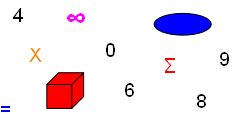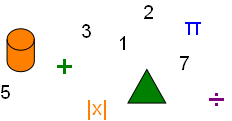



Using Cramer’s Rule to Solve a System of Linear Equations



Gabriel Cramer (1704-1752)
Cramer’s Rule, named for the Swiss mathematician Gabriel Cramer, requires the understanding of determinants to solve a system of linear equations.
If the determinate equals zero Cramer’s Rule does not apply and the system of linear equations has either; 1) No solution, represented geometrically as parallel lines, or 2) Has infinite solutions, where at every point the equations represent the same line.
Cramer’s Rule for Solving a 2×2 System:
To determine a mechanical procedure for solving a system of two linear equations in two variables observe:
Matrix A
a1 | b1 |
a2 | b2 |
det(A) = a1b2 − a2b1
Matrix B
k1 | b1 |
k2 | b2 |
det(B) = k1b2 − k2b1
Now consider two linear equations in two variables.
a1x + b1y = k1
a2x + b2y = k2
To eliminate y, multiply both sides of A by b2 and both sides of B by −b1.
a1b2x + b1b2y = k1b2
−a2b1x + −b2b1y = −k2b1
Add the two equations.
x(a1b2 − a2b1) = k1b2 − k2b1
The result is
x det(A) = det(B)
If the left-side equation determinate given by (a1b2 − a2b1) is not zero then
x = det(B) / det(A)
The determinate of the denominator has the coefficients of x and y as they are in the original equations. Call this the Determinate D:
a1x + b1y = k1
a2x + b2y = k2
=
a1 | b1 |
a2 | b2 |
=
det(A) = D
The determinate of the numerator, Dx, is obtained from D by replacing the a’s (coefficients of x) by the corresponding k’s:
Dx =
k1 | b1 |
k2 | b2 |
So that x = Dx / D (if D ≠ 0)
Similarly it can be shown that Dy, the 2×2 determinant obtained from D by replacing the b’s (coefficients of y) by the corresponding k’s is:
Dy =
a1 | k1 |
a2 | k2 |
And if D ≠ 0 then y = Dy / D
Thus, to solve by Cramer’s Rule two linear equations having two variables:
Linear Equations System
10x − 7y = 12
3x − 2y = 5
D =
10 | −7 |
3 | −2 |
=
10(−2) − 3(−7) = 1
Dx =
12 | −7 |
5 | −2 |
=
12(−2) − 5(−7) = 11
Dy =
10 | 12 |
3 | 5 |
=
10(5) − 3(12) = 14
If D ≠ 0; then by Cramer’s Rule…
x = Dx / D = 11 / 1 = 11
y = Dy / D = 14 / 1 = 14
The unique solution to the linear equation system is (11, 14).
Copyright © DigitMath.com
All Rights Reserved.